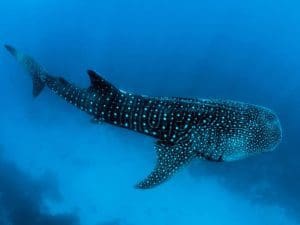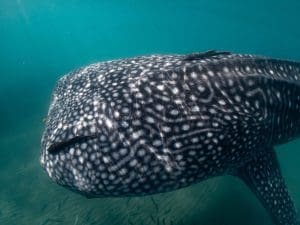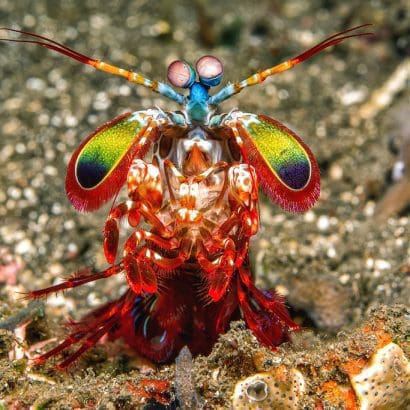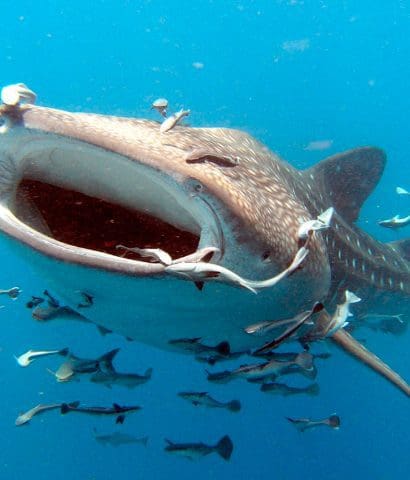
The whale shark, Rhincodon typus, is a magnificent creature that inhabits the world’s tropical and subtropical oceans. It is the largest fish in the world, with adults reaching lengths of up to 40 feet (12 meters) and weights of over 20 tons. Despite its massive size, the whale shark is a gentle giant, feeding mainly on plankton and small fish. In this article, we will explore the fascinating world of the whale shark, including its physical characteristics, feeding behavior, and conservation status. Join us on a journey to discover one of the most incredible creatures that the ocean has to offer.
Contents
- History of the whale shark.🐋
- Characteristics of the whale shark.🐋
- The Feeding Behavior of the Whale Shark.🐋
- How Much Does the Whale Shark Eat?.👀
- Why is the Whale Shark Endangered?.🆘
- What is being done to protect the whale shark?.✔
- Curiosities of the whale shark.👀
- What is the life cycle of a whale shark?.❤
- The importance of whale shark conservation.🐋
History of the whale shark.🐋
The whale shark is one of the oldest animals that inhabits the ocean. The first whale shark fossils date back to the Eocene period, about 50 million years ago. However, little is known about its evolution over time due to the lack of reliable fossils and records.
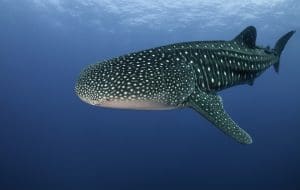 In popular culture, whale sharks have long been known by local fishermen in countries such as the Philippines and Mexico, who have called them “butanding” and “domino,” respectively. Despite their size, whale sharks were not frequently hunted due to their unappreciated meat and the difficulty of catching them. It was only in the 1980s that whale shark watching became popular in Central and South American countries, which contributed to the conservation of this species worldwide.
In popular culture, whale sharks have long been known by local fishermen in countries such as the Philippines and Mexico, who have called them “butanding” and “domino,” respectively. Despite their size, whale sharks were not frequently hunted due to their unappreciated meat and the difficulty of catching them. It was only in the 1980s that whale shark watching became popular in Central and South American countries, which contributed to the conservation of this species worldwide.
Until relatively recently, little was known about the biology and behavior of the whale shark. However, in recent decades, scientists have been able to study these animals more closely through the use of advanced technology such as tracking devices and DNA analysis. These studies have revealed valuable information about the ecology, reproductive biology, migration, and feeding patterns of whale sharks.
Characteristics of the whale shark.🐋
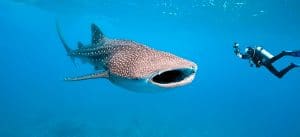 The whale shark is the largest fish in the world, with an average size of between 9 and 12 meters in length and a weight of over 20 tons. Its body is large, cylindrical, and torpedo-shaped, and its skin is thick and rough to the touch. The head of the whale shark is very wide and flat, and its mouth can measure up to 1.5 meters wide. It has a large number of small, non-sharp teeth, and filters water to obtain food.
The whale shark is the largest fish in the world, with an average size of between 9 and 12 meters in length and a weight of over 20 tons. Its body is large, cylindrical, and torpedo-shaped, and its skin is thick and rough to the touch. The head of the whale shark is very wide and flat, and its mouth can measure up to 1.5 meters wide. It has a large number of small, non-sharp teeth, and filters water to obtain food.
Unlike other sharks, the whale shark has large, distinctive spots on its skin, which can be white, yellow, or gray, and can vary in shape and size. These spots are unique to each individual and are used to identify and track whale sharks in scientific studies.
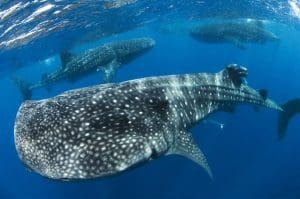 The whale shark is a pelagic species and is found in tropical and subtropical waters around the world. It can often be found in areas with abundant plankton, which is its main source of food. To feed, the whale shark swims slowly with its mouth open and filters water to capture small crustaceans, fish, and plankton. It can consume up to 75 pounds of food per day.
The whale shark is a pelagic species and is found in tropical and subtropical waters around the world. It can often be found in areas with abundant plankton, which is its main source of food. To feed, the whale shark swims slowly with its mouth open and filters water to capture small crustaceans, fish, and plankton. It can consume up to 75 pounds of food per day.
In addition to its size and distinctive spots, the whale shark is also known for its calm and curious nature. It often approaches boats and divers in the water without being aggressive, making it a popular animal for marine life observation.
The Feeding Behavior of the Whale Shark.🐋
The whale shark is a filter-feeding animal that feeds mainly on plankton, krill, fish eggs, small crustaceans, and small fish. Although it is an enormous animal, its diet is largely microscopic. To feed, it swims slowly with its mouth open, and by a system of water filtering, food particles are trapped in its gills. The shark then closes its mouth and swallows the water, while expelling indigestible water through its gills.
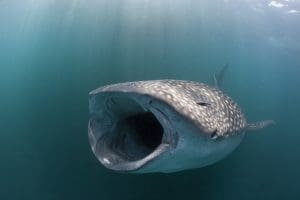 The whale shark can filter up to 6,000 liters of water per hour, allowing it to capture a significant amount of food in a short time. Although it is a predator, it rarely actively pursues its prey, instead feeding passively by swimming along columns of plankton and filtering the water as it goes.
The whale shark can filter up to 6,000 liters of water per hour, allowing it to capture a significant amount of food in a short time. Although it is a predator, it rarely actively pursues its prey, instead feeding passively by swimming along columns of plankton and filtering the water as it goes.
It is important to mention that although the whale shark feeds mainly on plankton, it has also been seen feeding on small fish and crustaceans. This behavior is more common in young whale sharks that are still growing and require more protein in their diet. Additionally, they may also consume foods such as jellyfish and squid on occasion.
How Much Does the Whale Shark Eat?.👀
The whale shark is an animal that consumes large amounts of food due to its size. It is estimated that an adult whale shark can consume around 30 kg of food per day. However, this number can vary depending on several factors, such as the availability of food in its natural habitat and the season of the year.
Why is the Whale Shark Endangered?.🆘
Although the whale shark is the largest fish in the world, it is endangered due to human activity. The whale shark is a very vulnerable species due to its low reproduction rate and slow growth.
One of the main threats to the whale shark is accidental fishing. Whale sharks often get caught in trawling or longline fishing nets, which are intended to capture other fish species. Often, whale sharks die as a result of this accidental fishing.
In addition, the whale shark is also hunted for its meat, skin, and fins, which are highly valued in the shark fin trade industry. This trade is illegal in many countries, but it still continues in many parts of the world.
Habitat degradation also poses a threat to the whale shark. Water pollution and coral reef destruction can severely affect their natural habitat and decrease the amount of food available to them.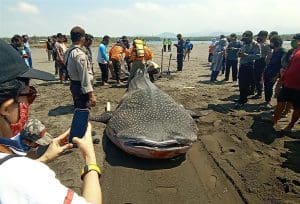
Although conservation measures have been established to protect the whale shark, there is still much to be done to ensure its long-term survival. Education and public awareness are key to promoting conservation and reducing the threats facing this unique marine species.
What is being done to protect the whale shark?.✔
The whale shark is classified as a vulnerable species, which means it is endangered. To protect this species, conservation measures have been established around the world.
One of the most effective conservation measures is the legal protection of the whale shark. Hunting and capture of the whale shark have been banned in many countries, and those that still allow fishing control the amount that is caught. In addition, the trade of whale shark fins is prohibited by the Convention on International Trade in Endangered Species of Wild Fauna and Flora (CITES).
Education and public awareness are also essential for whale shark protection. Education and public outreach programs help to increase awareness about the importance of the whale shark and its conservation. Furthermore, scientific research on the behavior and ecology of the whale shark is crucial for developing effective conservation measures.
Other conservation measures include the creation of protected areas for whale shark conservation, the promotion of sustainable tourism, and international collaboration between countries to protect this endangered species.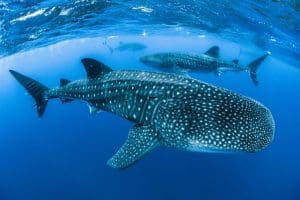
Although conservation measures have been established, there are still significant challenges in protecting the whale shark. It is crucial that conservation efforts continue and intensify to ensure the long-term survival of this iconic and unique species in the marine world.
Curiosities of the whale shark.👀
- The whale shark is the largest fish in the world, reaching up to 12 meters in length and weighing over 21 tons.
- Despite its large size, the whale shark primarily feeds on plankton, small fish, and crustaceans.
- Unlike other sharks, the whale shark is harmless to humans and can be swum and dived with up close.
- The pattern of spots on each whale shark’s skin is unique, like a fingerprint, allowing scientists to identify and track specific individuals.
- Whale sharks have a highly efficient filtering system that allows them to filter large amounts of water for their food, up to 2,000 tons of water per hour.
- Despite their large size, whale sharks are capable of leaping out of the water, a behavior known as “breaching.”
- The whale shark is a migratory species and can be found in tropical and temperate waters worldwide, from the west coast of North America to Southeast Asia and the east coast of Africa.
- Although the whale shark is a vulnerable species due to fishing and habitat degradation, it is an important tourist attraction for many coastal communities worldwide, which has led to increased interest in conservation efforts.
What is the life cycle of a whale shark?.❤
- The female deposits eggs into the water, but these hatch within the mother’s body.
- Young whale sharks are born as live, fully-formed pups measuring between 40 and 60 cm in length.
- Whale sharks grow rapidly, reaching sexual maturity at around 30 years of age when they measure about 9 meters in length.
- The mating season typically occurs between March and April.
- A female can give birth to up to 300 pups at once, although she normally has between 20 and 30 pups.
- While whale sharks can live up to 70 years, little is known about their lifespan in the wild due to their migratory behavior and the difficulty of studying them.
The importance of whale shark conservation.🐋
Conservation of the whale shark is of great importance for the balance of the marine ecosystem. These animals are crucial in maintaining biodiversity and the health of the oceans as they are the main predators in their natural habitat.
Furthermore, the whale shark is an emblematic species and plays a vital role in marine wildlife tourism. Preserving these animals not only helps to protect the species but also benefits the local communities that depend on tourism for their livelihoods.
However, the whale shark faces many threats such as accidental fishing, poaching, pollution, and climate change. It is important to take measures to protect these animals and their habitat through the implementation of sustainable fishing regulations, reducing pollution, and educating people about the importance of their conservation.